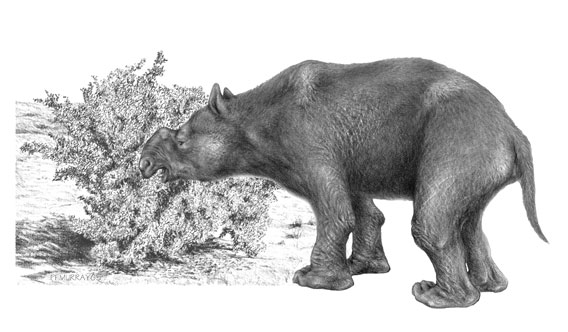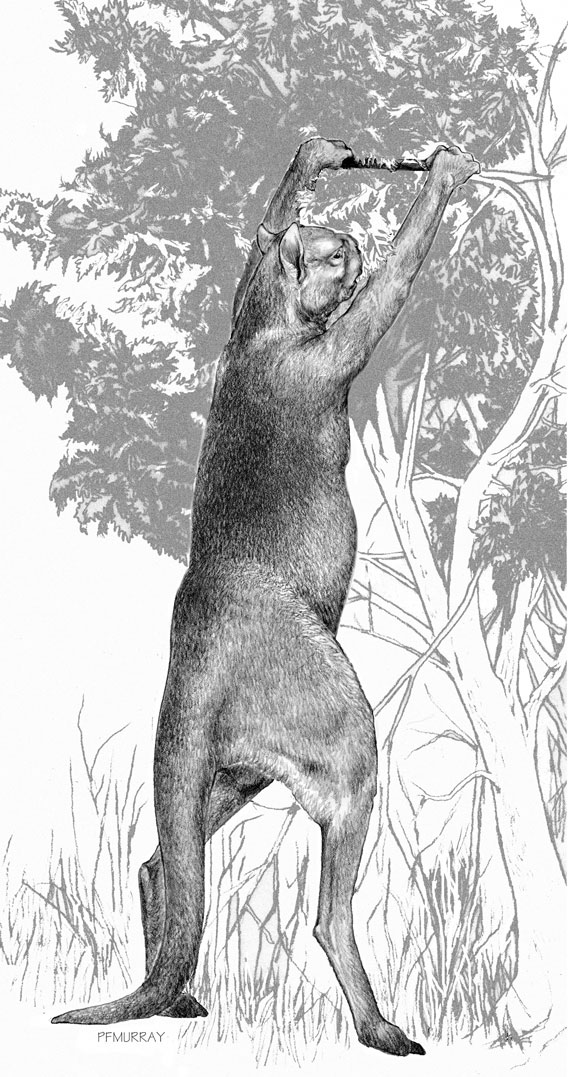
An extinct marsupial mega-herbivore, Diprotodon optatum. Drawing by Peter Murray. Image © Science/AAAS.
The theory that humans, and not climate change, was primarily responsible for the extinction of giant marsupials in prehistoric Australia takes another step forward with a new study in Science. Exploring sediment cores for past evidence of big herbivores, researchers found that the arrival of humans coincided with the loss of a menagerie of magnificent beasts, from giant kangaroos to fearsome marsupial lions and monster birds to Komodo dragon-like reptiles. The decline of this megafauna ultimately led to ecological changes that may have caused Australia’s rainforest to become savannah.
To help determine what killed off Australia’s megafauna, researchers sought fossilized Sporormiella: fungal spores that depend on the dung of big herbivores for survival. Taking two sediment cores from Lynch’s Crater in northwest Australia, researchers found ample evidence of Sporormiella—and thereby mega-herbivores like the rhino-sized Diprotodon—until around 41,000 years ago “when Sporormiella counts dropped almost to zero,” the scientists write. Forty-one thousand years ago just happens to be the approximate time of human arrival in Australia.
Although scientists found evidence of two climate change impacts in the sediment cores, both occurred before the extinction of the megafauna. In other words, the big marsupials survived past climatic upheavals only to be hunted to extinction by humans.
“[Megafauna] was insensitive to episodes of climate drying, before declining abruptly during a period of stable climate,” the researchers note.
Just as controversial, or even more so, the scientists argue that the demise of Australia’s megafauna to an onslaught of human hunters may have resulted in the demise of most of the continent’s rainforests.
“Large herbivores have strong effects on ecosystems, by maintaining vegetation openness and patchiness, removing material that would otherwise fuel landscape fire, dispersing seeds, and physically disturbing soil and recycling nutrients. Therefore, megafaunal extinction might have caused major changes to vegetation and the functioning of ecosystems,” the scientists write.
In the sediment cores the scientists found a rise fires, represented by charcoal, following soon after the extinction of megafauna. They hypothesize that a lack of big herbivores allowed fires to occur more often “by allowing the accumulation of fine fuel,” which big herbivores use to clean-up. While they admit that it’s possible the rise in fires was due to humans, they note the evidence points more toward a sudden lack Australia’s big herbivores. The loss of key species and the increase in fire eventually resulted in an ecosystem changeover: from wet mixed rainforest to dry savannah dominated by eucalyptus.
The study has important implications for today. As an already-dry Australia begins to suffer the effects of climate change, some scientists have suggested implementing trial programs to re-wild a portion of Australia with exotic megafauna to see if they could provide long-lost ecological services.
CITATION:The Aftermath of Megafaunal Extinction: Ecosystem Transformation in Pleistocene Australia. Susan Rule,
Barry W. Brook,
Simon G. Haberle,
Chris S. M. Turney,
A. Peter Kershaw,
and Christopher N. Johnson. Science. 23 March 2012: 335 (6075), 1483-1486. DOI:10.1126/science.1214261.

Sthenurus, an extinct browsing kangaroo. Drawing by Peter Murray. Image © Science/AAAS.
Related articles